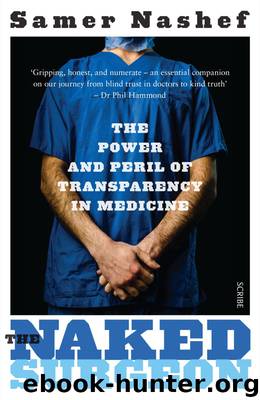The Naked Surgeon by Nashef Samer;

Author:Nashef, Samer;
Language: eng
Format: epub
Tags: SCI000000, MED085000, HEA028000, BUS033040, MED037000
Publisher: Scribe Publications
Published: 2015-06-03T16:00:00+00:00
Are you aware of other surgeons doing this?
Of the 115 surgeons who responded to the survey questions, 35 (just under a third) admitted to denying surgery to patients who may benefit because of concern about their figures, and the great majority (84 per cent) reported that they were aware of other surgeons doing the same thing.
This survey has confirmed without any doubt that the clinical decision-making process of surgeons has indeed been adversely affected by the culture of transparency. Most surgeons who responded to the survey reported that they had seen such risk-averse behaviour in their colleagues, and nearly a third were honest enough to have reported such behaviour in themselves. The best interests of the patient, which should always come first, have had to take second place to the league tables.
With a health economist’s hat on, one could argue that healthcare systems should probably not be offering high-risk surgery to anyone. The fact that such surgery is expensive, that resources are limited, and that the risk makes the operation less beneficial than in a young, otherwise fit person would seem to back this view, but we are forgetting two important considerations when we follow such a train of thought. The first is that doctors are primarily here to do the best for their patients (and not for the healthcare budget or their league-table figures). The second is the cardiac surgical paradox: the more an operation is likely to kill you, the better it is for you. This is simply because, in many such patients, withholding an operation has such a dismal outcome that the risk is more than amply justified. Yet withholding an operation and similar risk-averse behaviour unfortunately happens all too frequently. It is another reason why we should approach league tables with great care and circumspection. Sometimes, the price of transparency is unacceptable. Our poor old patient, if she is refused an operation, will die and become a statistic, but not a statistic that appears in the league table of heart surgery, and nobody will ever know.
Transparency is here to stay, and nothing we can do will turn the clock back. We can mitigate some of its damage by ensuring that the data are as accurate as possible, that all published data are properly adjusted for risk, that the analysis is statistically sound, and that the data are presented intelligently, but no matter what we do, we can never get away from the fact that, for a surgeon, the easiest and most effective way to reduce mortality is to say ‘No’ to high-risk patients, that the temptation to do so is a strong one, and that many surgeons will yield to it. There are, however, two things we can do. The first is to introduce a structure that allows surgeons to take on very high-risk patients without fear of damaging their own career and professional status, as illustrated by something called the Star Chamber.
When it comes to operating on very high-risk patients, the following facts are apposite.
Download
This site does not store any files on its server. We only index and link to content provided by other sites. Please contact the content providers to delete copyright contents if any and email us, we'll remove relevant links or contents immediately.
| Anesthesiology | Colon & Rectal |
| General Surgery | Laparoscopic & Robotic |
| Neurosurgery | Ophthalmology |
| Oral & Maxillofacial | Orthopedics |
| Otolaryngology | Plastic |
| Thoracic & Vascular | Transplants |
| Trauma |
Periodization Training for Sports by Tudor Bompa(8170)
Why We Sleep: Unlocking the Power of Sleep and Dreams by Matthew Walker(6618)
Paper Towns by Green John(5087)
The Immortal Life of Henrietta Lacks by Rebecca Skloot(4525)
The Sports Rules Book by Human Kinetics(4290)
Dynamic Alignment Through Imagery by Eric Franklin(4116)
ACSM's Complete Guide to Fitness & Health by ACSM(3989)
Kaplan MCAT Organic Chemistry Review: Created for MCAT 2015 (Kaplan Test Prep) by Kaplan(3939)
Introduction to Kinesiology by Shirl J. Hoffman(3721)
Livewired by David Eagleman(3682)
The Death of the Heart by Elizabeth Bowen(3551)
The River of Consciousness by Oliver Sacks(3536)
Alchemy and Alchemists by C. J. S. Thompson(3448)
Bad Pharma by Ben Goldacre(3354)
Descartes' Error by Antonio Damasio(3229)
The Emperor of All Maladies: A Biography of Cancer by Siddhartha Mukherjee(3063)
The Gene: An Intimate History by Siddhartha Mukherjee(3047)
The Fate of Rome: Climate, Disease, and the End of an Empire (The Princeton History of the Ancient World) by Kyle Harper(3003)
Kaplan MCAT Behavioral Sciences Review: Created for MCAT 2015 (Kaplan Test Prep) by Kaplan(2936)
